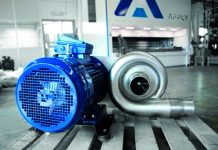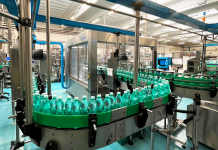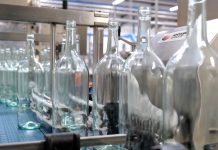Liquid-filling equipments vary depending on such factors as product viscosity, product temperature at the filling stage, tendency to entrain air, surface tension, frothing or foaming tendencies, etc.(1); carbonated beverages form a class of their own. Packaging material also has to be considered. Here are the main factors affecting filling technique choice:
- Product viscosity. “Wet” or liquid products range from low-viscosity free-flowing liquids to viscous semiliquids to extremely viscous products that might better be classed as semisolids. For water, wine, beer, vinegar and soft drinks, viscosity values are very low, usually between 1 and 10 cP (centipoise); vegetable oils, fruit juices and some sauces have intermediate viscosity values, usually between 10 and 2000 cP; this value is exceeded by dense sauces as tomato and tomato-based sauces, ketchup, mayonnaise, and so on: they can reach up to 10000 cP(2).
- Presence of gas. Sparkly beverages can contain from 1,5 to 5 volumes of carbon dioxide (CO2); every volume of dissolved CO2 corresponds to ca. 2 g/L and produces a pressure of ca. 1 atm, at room temperature (3). In order to avoid loss of added CO2, liquid inside the supply tank is kept refrigerated and under pressure to maximize CO2 dissolved in the liquid and foaming. Isobaric filling is therefore the ideal bottling method for carbonated drinks.
- Packaging material. Metal, rigid glass or heavy plastic containers can be accelerated and decelerated at high rates because they can endure significant force applied during filling or to the sidewalls during conveying, thus vacuum or pressure levels during the fill cycle are not critical parameters. On the contrary, semirigid containers, such as blow-molded plastic bottles, cannot withstand the same stresses: this poses limitations on the vacuum or pressure level that can be used during filling and moving the containers from station to station. Flexible pouches or bags must be retained in a fixture while being filled, and since flexible containers cannot be filled to a specified level, piston volumetric fillers are often used for them.
- Product value. No filler is perfectly accurate, and they must be considered in relation to product value; the challenge is to satisfy legal fill requirements without having excessive “giveaway”: the more accurate the system, the closer the machine can be set to declared fill. “Constant-level filling” is mostly used for low or moderate cost products such as soft drinks and beer, and/or for products where customer satisfaction demands that all containers are filled to the same level. With “constant-volume filling”, an accurate product volume is placed into the container: this is common for high-cost products or products where net weight must be strictly maintained (pharmaceuticals, sold by weight, etc.).
- Need of aseptic filling. In the case of spoilage-sensitive liquids that will not undergo post-packaging thermal sanitation processes, aseptic filling is needed to guarantee satisfactory shelf life. In this situation, the filling technique will be designed primarily to satisfy this standard.
An isobaric process is a thermodynamic process in which the pressure remains constant. In the case of isobaric filling, a back pressure similar to the one present inside the supply tank is generated inside the bottle, in order to perform a fast and effective filling. It is mainly applied to carbonated/fizzy drinks, which represent a large market share: soft drinks, sparkling water and wine, beer, etc. Isobaric filling can anyway be applied to all beverage kinds: this makes isobaric filling particularly suitable for bottling plants that handle many different beverages, both carbonated and still. Furthermore, it can be applied either to glass or PET bottles. Commonly isobaric fillers are rotary machines, with 100 or more filling heads. In an isobaric filler, bottles are lifted and hermetically secured to the filler head, equipped with sealing gasket and multiposition valve. Firstly, CO2 is allowed to flow into the bottle in order to pressurize it at the same level of the supply tank (giving the “isobaric” definition). Then the valve repositions to allow product to flow from the tank into the bottle. When the liquid level reaches the bottom of the vent tube, a check valve stops the filling process. A vent then opens to the atmosphere while sealing off the pressure equalization tube; this allows the container pressure to come down to atmospheric level. The process is virtually foam-free. In recent years, accurate and efficient systems have been designed in order to:
- precisely control filling level;
- make sure CO2 pressure inside bottle during filling is not overrun;
- protect bottle structure from stress and expansion;
- reduce residual oxygen inside bottle and thus product oxidation, or even introduce nitrogen head space in the case of liquids very sensitive to oxidation;
- implement single or double air pre-evacuation through special valves;
- automatically remove fragments and clean site in the case of bottle rupture (high foreign body risk);
- implement systems to reduce maintenance and make every change of liquid, bottle size or filling level easy and not time consuming;
- allow memorization of parameters and easy touch screen control of the whole equipment;
- introduce check valves able to guarantee maximum repeatability of filling levels even after extended stops;
- look after every detail in order to guarantee hygienic standards, making every part in direct contact with liquid as plane and easy to clean as possible; systems using “fake bottles” allow to clean the system with product recirculation.
Bibliography
1) Soroka W., Fundamentals of Packaging Technology. Institute of Packaging Professionals, 2009 (4th edition)
2) Piergiovanni L. and Limbo S., Food Packaging – materiali, tecnologie e qualità degli alimenti. Springer Editore, 2010
3) Ibid.






